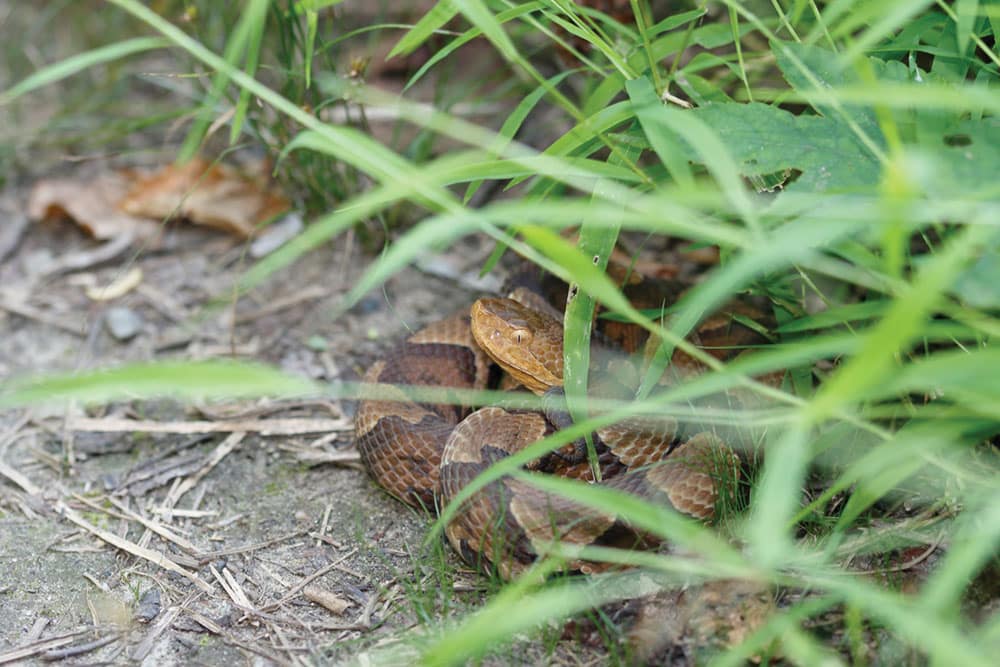Snake bites are on the rise in Southern states, particularly North Carolina. In 2018, the state reported the highest number of snake bites in the country, and in 2019, an early season report showed a 67% increase in snake bites over the previous year. Then in 2020, ABC 11 reported that WakeMed hospitals had treated nearly double the number of snake bites since 2018.
According to Anna Dulaney, a clinical toxicologist for North Carolina Poison Control: “Between 2010 and 2020 (our last year with full data), calls to N.C. Poison Control regarding snakebites increased from 534 to 963. In 2010, 76 were considered non-venomous, but 62 were classified as unknown snakes. In 2020, 49 were considered non-venomous and 166 were classified as unknown snake species.”
Scientists believe a range of factors are contributing to the rise in snake bites. Dulaney said that North Carolina’s population has significantly increased during the aforementioned time frame, which makes it possible that humans are infringing on snake habitats more. Tom Campbell, a South Carolina-based herpetologist, said it’s likely due to more people venturing outside.
“I think that’s probably the number one factor,” said Campbell. “And there’s probably a very low likelihood that they are educating themselves on wildlife in that area.”
North Carolina is home to 38 different snake species, but only a small number are venomous, including the copperhead, timber rattlesnake, and the cottonmouth. As pit vipers, those three species can deliver painful bites that cause burning and swelling. “All pit vipers venoms are necrotic, so it’s going to start to cause tissue damage almost immediately,” Campbell explained. “And they’re hemotoxins, so they’re going to attack cellular tissue like blood cells and skin cells.”
Across the world, 81,000-138,000 people die from snake bites each year. About a third of bite victims suffer amputations and additional injuries. And there are over five million snake bites reported globally each year. While venomous snake bites are most commonly reported in Africa, Asia, and Latin America, the United States sees a fair number of venomous bites each year.
In 2019, 92 venomous snake bites were reported in North Carolina. Although bite rates have increased in recent years, the associated death rate in the region is low, due to the accessibility of antivenom.
Anyone unfortunately bitten by a venomous snake can expect a lofty hospital bill, depending on the species and location of the bite. Campbell, who suffered a copperhead bite, estimates that a vial of antivenom can cost anywhere between $4,000 and $8,000, and he said that most rattlesnake bites are going to require about 8 to 12 vials.
Campbell was bitten while performing maintenance in a venomous reptile building. He noticed a snake escaping its enclosure, prompting him to pick it up with a snake hook. But the snake managed to lash out and snag his pinky finger. “There was immediate searing, burning pain at the site of the bite,” he recalled. “And the sensation of pressure like my finger was going to blow up. My whole hand hurt and everything was swollen up to my elbow.”
Although he’s since regained most of the function in his finger, Campbell said he still has limited nerve sensation, and his nail doesn’t grow correctly. He also advises anyone who sees a snake on a hike or in their backyard to stay a safe distance away. “If you ever encounter a wild animal, give it a wide berth, and leave it alone,” he said. “Admire it from a distance. Don’t try to pick it up.”
He also stressed that bites are rare, and snakes should not be demonized. They’re an essential part of local ecosystems, contributing to disease management and population control, particularly as apex predators of disease-carrying pests like rats, mice, and squirrels. “I think what’s most important is that as little as we know and as scared as we may be, there’s always value in snakes. Whether venomous or non-venomous, they fill a huge niche in biodiversity. They help to keep a balance in the wild.”
Bite Advice
Here’s what herpetologist Tom Campbell advises, if you’re bitten by a venomous snake.
- 1. Assume there was an envenomation and get treated immediately.
- 2. Don’t suck the site of the wound.
- 3. Don’t use a snake kit.
- 4. Try to identify the snake. Knowing the species helps medical care providers.
Cover photo: Copperhead snakes are pit vipers, found throughout the East Coast from southern New England down to Florida. Photo courtesy of Getty Images







